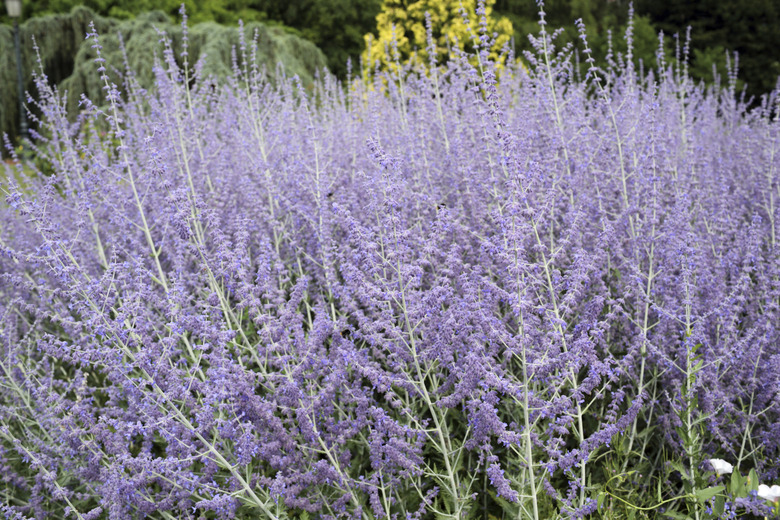How Is Russian Sage Poisonous?
Russian sage (Perovskia atriplicifolia) is a deciduous woody shrub in the mint family (Lamiaceae) that is native to central Asia and grown as a landscaping plant in U.S. Department of Agriculture plant hardiness zones 5 through 9. Although the aromatic shrub is called "sage," it is not a culinary herb. In fact, the plant contains a chemical that can be toxic in large doses.
General Description
With silvery-gray leaves and a generous display of lavender-colored blossoms, Russian sage is a popular choice to quickly fill in areas along foundations and fence lines. The plant is also used as a back border for low-growing evergreens and perennial flowers. It requires full sun and well-drained soil, and because it is drought tolerant it is often featured in xeriscape gardens. Although Russian sage isn't poisonous to deer, they do shy away from it.
- Russian sage (Perovskia atriplicifolia) is a deciduous woody shrub in the mint family (Lamiaceae) that is native to central Asia and grown as a landscaping plant in U.S. Department of Agriculture plant hardiness zones 5 through 9.
- With silvery-gray leaves and a generous display of lavender-colored blossoms, Russian sage is a popular choice to quickly fill in areas along foundations and fence lines.
- The plant is also used as a back border for low-growing evergreens and perennial flowers.
Chemical Composition
At least 10 compounds have been isolated from Russian sage for study and most of them are relatively innocuous. Lupeol, for example, also known as fagarsterol, is a plant sterol found in many plants and fruits with beneficial uses.
However, Russian sage also contains thujone, an organic compound that is chemically similar to menthol and is responsible for the scent of the leaves. Thujone is suspected of causing liver damage and is known to cause convulsions in laboratory animals, but only when consumed in large qualities over a long period of time.
Myths Dispelled
Thujone is also found in wormwood (Artemesia absinthium), a plant in the daisy family cultivated in USDA zones 4 through 9 and **a key ingredient in an alcoholic beverage known as absinthe.** Between 1912 and 2007, the U.S. imposed a ban on the manufacture, sale or import of absinthe in the belief that thujone caused hallucinations. However, the beverage itself may have contributed to reports of adverse effects due to having an alcohol content ranging between 55 to 72 percent, which translates to 110 to 144 proof.
It was eventually discovered that the thujone content in the drink was far less than previously thought, with some early accounts claiming the concentration to be as high as 350 mg per liter when it was actually only 5 mg or less per liter. The U.S. now permits the sale of absinthe with 10 parts per million (ppm) of thujone or less, while the maximum thujone content allowed in foods from other plant sources is 25 ppm.
Commonsense Precautions
Russian sage is not considered poisonous because it would take great effort to eat enough of it to get sick. Still, a cautious approach is sensible. The sprawling, upright habit of Russian sage might be attractive to young children, perhaps as a place to play hide and seek. If you have a dog that loves to chase a ball, the object of his affection could easily end up in the middle of the shrub. If either scenario applies to your household, it might be prudent to situate Russian sage in a place where children or pets won't become tangled in it and be tempted to sample its fragrant leaves.
- It was eventually discovered that the thujone content in the drink was far less than previously thought, with some early accounts claiming the concentration to be as high as 350 mg per liter when it was actually only 5 mg or less per liter.
- If either scenario applies to your household, it might be prudent to situate Russian sage in a place where children or pets won't become tangled in it and be tempted to sample its fragrant leaves.
References
- National Gardening Association: Russian Sage
- Floridata: Perovskia Atriplicifolia
- Colorado State University: Russian Sage
- Journal of The Chemical Society of Pakistan: Phytochemical Studies on Perovskia Atriplicifolia
- Cancer Letters: Lupeol, A Novel Anti-inflammatory and Anti-cancer Dietary Triterpene
- Missouri Botanical Garden: Artemesia Absinthium
- The Wormwood Society: Frequently Asked Questions About Absinthe
